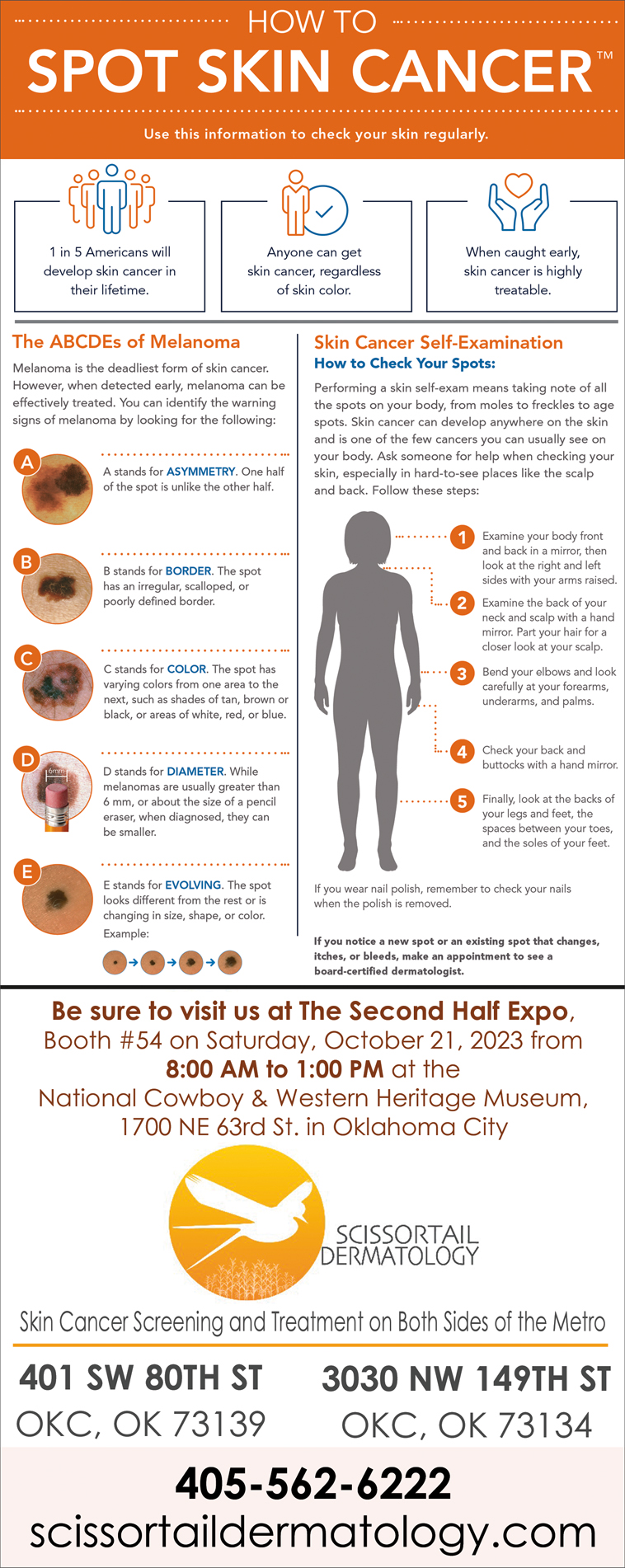Story and photo by Bobby Anderson, RN, Staff Writer

Your skin is your largest organ and the only one you can actually see and feel.
So as you age you might want to pay a little more attention to skin changes to prevent something minor from becoming something major.
That’s what one of the leading dermatologists in Oklahoma City tells her patients.
Dr. Elise Brantley is a board-certified dermatologist who has been practicing for more than 10 years.
Her practice at Scissortail Dermatology focuses on protecting your skin year-round.
“I think it’s a good idea for people to be aware of what the signs and symptoms of skin cancer are,” Brantley said. “Just so they know whether or not they need to come in. Another thing is for people to be aware of potential risk factors they may not realize.”
Scissortail Dermatology has offices on both the north and south sides of the metro.
You can learn more at their booth at the upcoming Second Half Expo being held at The National Cowboy and Western Heritage Museum in Oklahoma City, on Saturday, October 21 from 8 a.m. to 1 p.m.
The free event is the largest senior expo in Oklahoma and will feature 130 exhibits, lots of free giveaways as well as information on senior living, education, and retirement planning.
When it comes to people and their skin, oftentimes they’ll ignore the proverbial warning signs.
“Honestly, everyday especially in the younger population who work outside,” Brantley said. “A lot of people who spend or have spent a lot of time outside (are at risk).”
All those ball games, summers at the lake, and work outdoors will eventually catch up.
As you start to age accumulated exposure to the sun can begin to take its toll, resulting in blemishes and forms of skin cancer – some of which can be deadly if left untreated.
“Especially when they reach retirement age, that’s when the problem arises,” she said. “Before you get to cancer some people experience pre-cancers that are uncomfortable, tender, and make the skin rough. The skin surface is altered and a lot of our patients struggle with that.”
Brantley’s practice focus is the evaluation and treatment of growths of the skin with an emphasis on detecting and treating skin cancer.
She is a native Oklahoman from Broken Arrow.
After graduating high school from the Oklahoma School of Science and Mathematics she attended the University of Tulsa for undergraduate studies.
She received her medical degree from the University of Oklahoma and completed her residency training at the University of Cincinnati where she served as chief resident.
She has been serving the Oklahoma City metro area for more than 10 years.
Melanoma is the deadliest form of skin cancer. However, when detected early, melanoma can be effectively treatment. You can look for signs of melanoma by following the ABCDE method
Asymmetry is where one half of the spot is unlike the other half.
The spot has an irregular or poorly defined border
* C stands for color. The spot has varying colors from one area to the next, such as shades of tan, brown, black, or areas of white, red, or even blue.
* D stands for diameter. Melanomas are usually greater than six mm, or about the six of a pencil eraser, but can be smaller.
* E stands for evolving where a spot looks different than the rest or changes in size, shape, or color.
Performing a skin self-exam means taking note of all the spots on your body, from moles to freckles to age spots. Skin cancer can develop anywhere on the skin and is one of the few cancers you can usually see on your body. Ask someone for help when checking your skin, especially in hard-to-see places like the scalp and back.
The annual cost of treating skin cancers in the U.S. is estimated at $8.1 billion: about $4.8 billion for nonmelanoma skin cancers and $3.3 billion for melanoma, according to the Foundation.
Thanks to increased education and screening by dermatologists like Brantley, the diagnosis and treatment of nonmelanoma skin cancers in the U.S. increased by 77 percent between 1994 and 2014.
“It’s a great idea to come in for at least one assessment,” Brantley said. “Get an idea of what your risk factors are. You may not need to come in more than once a year. You may need to come in more often.”
For Brantley, an ounce of prevention is worth more than a pound of cure.
For more information or to make an appointment visit https://scissortaildermatology.com/ or call (405) 562-6222.















